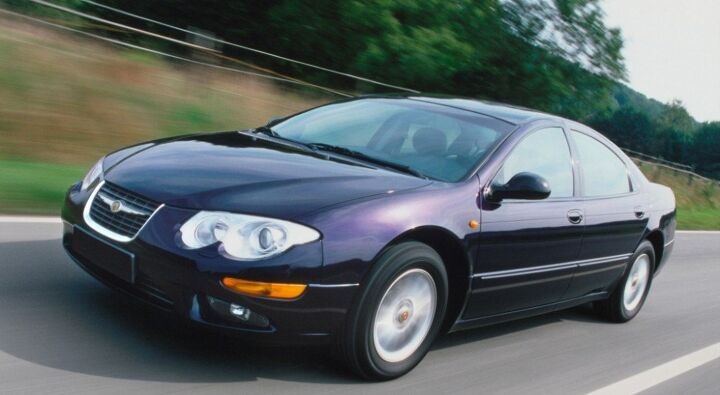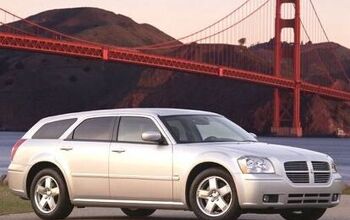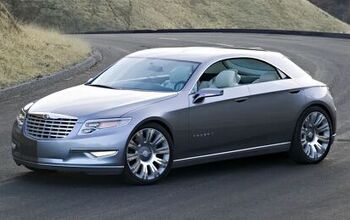Rare Rides Icons: In Memoriam, The Chrysler LX Platform (Part III)

Thus far in our Chrysler LX platform coverage, we’ve discussed two designs that never made it past the working concept stage. The first of those was the Airflite, a Crossfire-styled hardtop hatchback, while the second was the larger Nassau which was also a hardtop hatchback. Neither of them had pillars, and both focused on the future of car design.
Journalists made incorrect predictions at the debut of both concepts and stated that the Airflite (in 2003) previewed the upcoming 300’s styling, while the Nassau (in 2007) was a sneak peek at a new styling direction for the 2008-ish revamp of the then-current 300. While those assumptions were wrong, a never-debuted Nassau design from 2000 was the actual genesis of the 300’s styling. And it appeared on the new LX platform in 2005.
The LX was derived from the deceased front-drive LH platform, which as we know was benchmarked to the AMC-generated and Renault-derived Eagle Premier. Chrysler aimed for product differentiation with its new platform, and some within the company knew that while its previous front-drive LH cars were successful, every mainstream manufacturer offered that sort of product as well.
Chrysler found in its research that the consumer’s impression of a rear-drive car was almost always associated with a higher price. Product development realized it could make more profit on each car and get the differentiation it desired with a rear-drive platform. It was not as easy to convince Chrysler’s engineers of the move to rear-drive, as they preferred to make a new version of the front-drive LH.
In the late Nineties Chrysler began such a development: a revised take on the LH to carry Chrysler through the middle and latter part of the 2000s. However, the company reached the end of its independence days at the time, as in 1998 it merged with Daimler-Benz AG and became Daimler-Chrysler AG. Shortly after the merger, management decided to call the LH a day and drop further development.
For its part, the LH platform was designed so it could easily swap between front- and rear-drive. In the end, the persuasive product people (and Daimler with its execution of LH development) came to an understanding with the engineers on a rear-drive platform. Though it was in theory a merger of equals, the management at Daimler stated it was also important to save money and to use things Mercedes-Benz had already engineered.
As mentioned above, what happened, in the end, was a derivative of the LH platform. LH was reworked to be rear-wheel drive and used a front suspension that Chrysler developed “itself” (see below) while its rear suspension was from a contemporary Mercedes E-Class (W210, 1995-2003). Mercedes also provided a 5G-Tronic five-speed automatic, which was a new feature of the E-Class in 1997.
However, there is not agreement between sources about just how much parts sharing there was between Mercedes and Chrysler on the LX. While Chrysler claims to have developed the front-end suspension itself, other sources suggest the double wishbone setup was derived from the S-Class (W220, 1999-2005). Further, it’s also suggested the lower control arms in the LX suspension were taken from AMG’s E55, and are interchangeable between the two cars. All-wheel drive examples of the 300 used the Mercedes 4MATIC system from the E-Class and its transfer case.
Other assertions of Mercedes parts usage include the driveshaft, differentials, the ABS system, cabin electrics, engine modules, and the steering. It doesn’t end there, as the 300 featured the cruise control stalk from the E-Class, as well as seat control buttons, HVAC internals, and its wiring harness. Again, information varies depending on who’s answering the questions.
Less up for discussion were the platform’s new dimensions. The translation of the LH platform into LX brought with it an increase in wheelbase. The 300M of 2004 used a 113-inch wheelbase, a full seven inches shorter than the 120-inch wheelbase of the subsequent 300.
Despite the longer wheelbase and how the cars looked on the outside, the 300M and 300 were the exact same length: 197.8 inches. Width shrunk by .3 inches, from 74.4” to 74.1” with the move to the LX platform. The overall height of the new 300 was 58.4 inches, a jump of 2.4 inches from an LH 300M. Chrysler made the LX cars taller to give them a more distinctive shape.
Said distinctive shape was a referential one, as penned first by Tom Gale and then finalized by Ralph Gilles and Freeman Thomas. Thomas was new to Chrysler from Volkswagen and was appointed VP of Daimler-Chrysler’s Advanced Product Design Strategy. Gale retired before the Nassau concept made the move toward production as the 300.
The new 300 was penned as a modern interpretation of the classic C-300 of 1955. The Imperial-adjacent 300 was also designed by Virgil Exner and shared similar looks to the independent and upscale Imperial. Rather than credit the unreleased Nassau design of 2000, Chrysler made a reference to the Chrysler Chronos of 1998 (above). We’ll leave it up to you to decide which is closer in looks to the production car.
The 300’s bold styling was led by its large egg crate grille at a time when the oversized grille was just arriving to its modern usage. With Chrysler’s gold ribbon logo sporting large wings, the 300’s face appeared almost vertical. Large headlamps were rounded on the outside and sharp on the inside and recessed slightly from the grille.
The sedan had a large one-piece front clip that included the bumper cover, lower valance, and grille. Upper trims (SRT8 shown) had large fog lamps astride some air inlets in the lower valance, and headlamp sprayers set into bumper-like trim underneath the headlamps.
Elsewhere, the 300 was strong, solid, and blocky looking. The large hood was almost flat save for a minor power bulge and curved down to meet the headlamps. Fenders also wrapped around the headlamps and then headed toward the rear. The 300’s character line was interrupted by very strong front wheel arches but was otherwise nearly horizontal.
The side profile of the 300 had a minimal amount of decoration, apart from its door rub strip and a trim name badge at the front fender. Upright and formal, the 300 also looked hunkered down and sporty. Chrysler succeeded in its reference to the Fifties “gentleman’s muscle car” that was the 300.
The rear end sported a high deck, and a simple and squared-off trunk lid. It had a strong character line at its lower quarter that was similar in effect to the side character line. The trunk also sported a large Chrysler logo and a trim designation badge on occasion. Below, there was a very simple bumper with minimal trim or decoration, just cut-outs for the exhausts and a place for the license plate.
A handsome-looking car for the 2000s, and certainly more appealing than most (or all) of the rather mushy-looking second-generation LH cars. It also succeeded in looking different from most anything on the road at the time. Next time we’ll have a look at the interior accommodation of the 300, and talk about trim and mechanical details.
[Images: Chrysler]
Become a TTAC insider. Get the latest news, features, TTAC takes, and everything else that gets to The Truth About Cars first by subscribing to our newsletter.

Interested in lots of cars and their various historical contexts. Started writing articles for TTAC in late 2016, when my first posts were QOTDs. From there I started a few new series like Rare Rides, Buy/Drive/Burn, Abandoned History, and most recently Rare Rides Icons. Operating from a home base in Cincinnati, Ohio, a relative auto journalist dead zone. Many of my articles are prompted by something I'll see on social media that sparks my interest and causes me to research. Finding articles and information from the early days of the internet and beyond that covers the little details lost to time: trim packages, color and wheel choices, interior fabrics. Beyond those, I'm fascinated by automotive industry experiments, both failures and successes. Lately I've taken an interest in AI, and generating "what if" type images for car models long dead. Reincarnating a modern Toyota Paseo, Lincoln Mark IX, or Isuzu Trooper through a text prompt is fun. Fun to post them on Twitter too, and watch people overreact. To that end, the social media I use most is Twitter, @CoreyLewis86. I also contribute pieces for Forbes Wheels and Forbes Home.
More by Corey Lewis
Latest Car Reviews
Read moreLatest Product Reviews
Read moreRecent Comments
- Amy I owned this exact car from 16 until 19 (1990 to 1993) I miss this car immensely and am on the search to own it again, although it looks like my search may be in vane. It was affectionatly dubbed, " The Dragon Wagon," and hauled many a teenager around the city of Charlotte, NC. For me, it was dependable and trustworthy. I was able to do much of the maintenance myself until I was struck by lightning and a month later the battery exploded. My parents did have the entire electrical system redone and he was back to new. I hope to find one in the near future and make it my every day driver. I'm a dreamer.
- Jeff Overall I prefer the 59 GM cars to the 58s because of less chrome but I have a new appreciation of the 58 Cadillac Eldorados after reading this series. I use to not like the 58 Eldorados but I now don't mind them. Overall I prefer the 55-57s GMs over most of the 58-60s GMs. For the most part I like the 61 GMs. Chryslers I like the 57 and 58s. Fords I liked the 55 thru 57s but the 58s and 59s not as much with the exception of Mercury which I for the most part like all those. As the 60s progressed the tail fins started to go away and the amount of chrome was reduced. More understated.
- Theflyersfan Nissan could have the best auto lineup of any carmaker (they don't), but until they improve one major issue, the best cars out there won't matter. That is the dealership experience. Year after year in multiple customer service surveys from groups like JD Power and CR, Nissan frequency scrapes the bottom. Personally, I really like the never seen new Z, but after having several truly awful Nissan dealer experiences, my shadow will never darken a Nissan showroom. I'm painting with broad strokes here, but maybe it is so ingrained in their culture to try to take advantage of people who might not be savvy enough in the buying experience that they by default treat everyone like idiots and saps. All of this has to be frustrating to Nissan HQ as they are improving their lineup but their dealers drag them down.
- SPPPP I am actually a pretty big Alfa fan ... and that is why I hate this car.
- SCE to AUX They're spending billions on this venture, so I hope so.Investing during a lull in the EV market seems like a smart move - "buy low, sell high" and all that.Key for Honda will be achieving high efficiency in its EVs, something not everybody can do.






































Comments
Join the conversation
I think part of the decision to go RWD was the huge popularity of BMW and ze other Germans in the luxury market of the late '90s. As those cars become the new standard choice in luxury cars, it made RWD "aspirational" again. So makes sense that people associated it with higher-trim vehicles.
To me the move to LX was almost as dramatic as the shift to LH after the K-cars. A huge reinvention, like "Hey guys! It's the New Jan Brady!"
IMO LX also helped bring back the "old-school" RWD V8 muscle car scene, which was starting to lose momentum in the '90s with most attention going to JDM, original F&F type stuff (at least here in SoCal). Now that scene is beyond healthy again...I think the LX's (especially Charger and the SRTs) helped a lot.
The LH with its north-south fwd drivetrain could have been offered with awd. An awd Eagle Vision might have roped in some AMC Eagle owners as well as folks who weren’t ready for a Jeep.